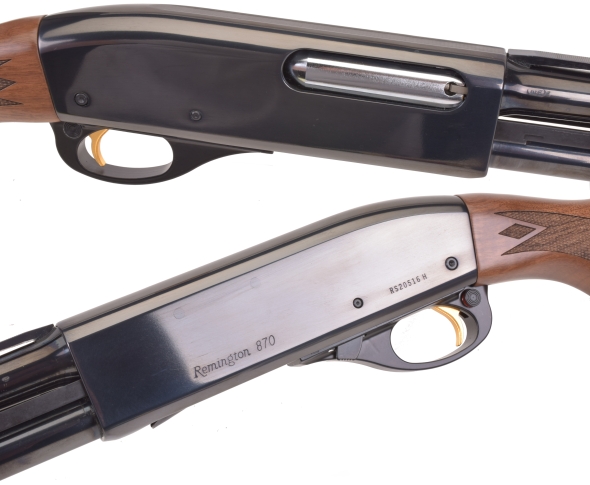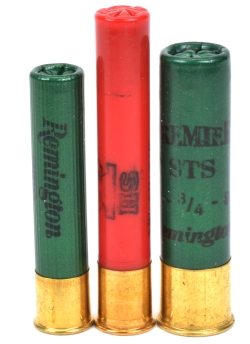
My wife’s birthday is near, which means I have a good deal more time to write as I settle into each new hiding place. Being two years older should give me insight into her time of consternation, but it doesn’t and it won’t, so I just settle for making myself scarce and riding out the storm. Men are from Mars and women are, apparently, from New Jersey.
The morning was spent shooting a 28 gauge Remington Model 870 Wingmaster. A basic, but nicely done pump action shotgun that proved to be light, fast and a very good piece of machinery for exploding feeling clay targets launched from a trap. It was… fun. At 6 lbs and without a recoil pad, it kicked enough to make it interesting and its stock geometry and simple dual beads on a vented rib gave it a natural point.
Remington’s Pump Shotguns
The current Remington Model 870 was announced in 1950 , the 28 gauge chamber was added in 1969. 1) The Model 870 is the sixth in a progression of Remington pump shotguns, which takes Remington into its 106th year of producing this type of product.
| Remington Model Pump Action |
Years Produced |
Designers |
| Repeating Shotgun | 1908-1910 | Pedersen |
| Model 10 | 1911-1928 | Pedersen, Loomis, Barger |
| Model 17 | 1917-1933 | Browning, Pedersen |
| Model 29 | 1929-1933 | Loomis |
| Model 31 | 1931-1949 | Loomis |
| Model 870 | 1950 – | Crittendon, Haskell, Hailston, Pinckney |
The Remington Repeating Shotgun of 1908 became the Model 10… in 1911. It marked Remington’s first foray into pump action shotguns. Solid breech, 12 gauge, hammerless and bottom eject. A total of 275,542 were produced with a limited number outfitted with bayonet lugs or without the lugs, but with 20″ barrels, that saw WW I service.
The Remington Model 17 was a 1913 John Browning design, licensed by Remington. Over the course of its run, 72,644 were produced. The Model 17 was also a bottom load and eject shotgun, however, it was a take down model and lighter in weight. IN 1919, after design refinements were made by John Pedersen, the Model 17 was made available in 20 gauge.
The Remington Model 29 offered 12 gauge 5 shot, rather than 3 shot capacity. It also has a simplified take down system and a cross bolt safety. Production was 37,933 over its run.
The Remington Model 31 was produced in 12, 16 and 20 gauge versions. Magazine capacity was 4 or 2. While this was also a bottom load, hammerless, take down, it was Remington’s first side eject shotgun. A total of 160,000 were manufactured.2)
This model, the Remington Model 870 has been in production since 1950. A new design that borrowed from Remington’s 11-48 autoloader, it featured a more secure lock up in a hardened barrel extension, a new locking block and a redesigned and improved slide. Over the years is had been produced in 12, 16, 20, 28 gauge and .410 bore. In continuous production for 64 years, over 10,000,000 have been produced. 3) Over the years, Remington build a well known reputation for designing and manufacturing superior shotguns, both autoloaders and pump action.
If you have an interest and have the opportunity, pick up a copy of “Remington Autoloading and Pump-Action Rifles” – Myszkowski. He includes a background on the Model 870 design team and the merged efforts of an all star cast of Du Pont and Remington Engineers. Each came to the effort with major prior accomplishments in both civilian and military firearm design.
The subject shotgun
The Model 870 Winchester is a slick pump action shotgun. It is so basic and the design is so nicely executed in manufacturing it is… elegant. I really appreciate the satin versus gloss finish. Walnut has a soft arm feel to it that is comfortable summer and winter. Even this Model 870’s gloss bluing looks right. It is a deep blue, almost black rather than some of the current oxide finished that look almost like plastic. I think you can see the oiled steel rainbow in the picture below.

|
Remington Model 870 Wingmaster |
|
| Manufactured | Remington – Ilion, NY. |
| Order # | 24983 |
| Type | Slide Operated |
| Gauge | 28 |
| Mag Capacity | 5/2 with plug |
| Barrel Length | 25″ |
| Rem Choke Inc | Imp Cylinder, Modified, Full |
| Weight | 6 Lbs |
| Overall Length | 45 1/2″ |
| Stocks | American Walnut – Satin Finish |
| Hardware | Steel – High Polish Blue |
| Length of Pull | 14″ |
| Drop at comb | 1 1/2″ |
| Drop at heel | 2 1/2″ |
| Sights | Vent Rib – Twin Bead |
| Scope | N/A |
| Trigger Pull | 4 Lbs. 3 Oz. |
| Safety | Cross Bolt |
| MSRP | $943 (Model Specific) |
|
Nominal Weights & Measures |
|

More clean lines, an absence of on product advertising and few controls to be concerned with when shooting. The Model 870 feels solid as a pump gun where many others sound… tinny. Maybe it’s a receiver machined from a single piece of steel that gives it that feel.
This 870 Wingmaster is supplied with a 2 shot magazine plug and lock. It utilizes the Rem Choke System and is supplied with a choke tube wrench as well as Full, Improved Cylinder, and Modified choke tubes. All of the shooting I did was with the Modified choke that is preinstalled at the factory.
The 28 gauge is not a minor gauge. I think it goes something like this…
 I’ve seen so many comparisons of the 28 gauge to the .410 bore and how the .410 bore has replaced the 28 gauge with almost identical performance, it all began to seem plausible… right up until I spent some time shooting this one and looking closely at ammunition and ballistics table. What about the dreaded .410 bore extended shot string?
I’ve seen so many comparisons of the 28 gauge to the .410 bore and how the .410 bore has replaced the 28 gauge with almost identical performance, it all began to seem plausible… right up until I spent some time shooting this one and looking closely at ammunition and ballistics table. What about the dreaded .410 bore extended shot string?
Most upland game birds fly between 30 and 40 MPH, even though they can burst to higher speed under dire circumstances, roughly 58 fps. Let’s say, at game taking distances, a .410 bore shot string is 9 feet and the shot is moving 900 fps. The tail of the string will hit the original plane of the leading shot in 1/100th of a second, which equates to 7″ of bird travel. Impressive until you realize the shot pattern, not string, is roughly 40″ at game taking distances and with the appropriate choke. Perhaps it is more important to make that 40″ pattern as dense as possible rather than worrying about spreading it out horizontally as game hardly ever moves rigidly laterally to the hunter. Increased pattern density is something the 28 gauge can clearly do more effectively than the .410.
The stringing of shot is attributed to shot at the rear of the column being obstructed and deformed by the bore of the shotgun and shot at the front of the column. This alters the trailing shot ballistic coefficient and its velocity. The softer the shot material, the longer the string; lead long string, steel, relatively short string. The larger the bore the shorter the string for a given shot size and weight because there are fewer layers of shot in the shot column and because there is less bore restriction.
A 28 gauge has a bore diameter of 0.550″
#6 shot has a diameter of 0.110″
A 3/4 Oz. #6 shot charge has 167 pellets
19 #6 pellets can reside on the same plane in a 28 gauge bore.
A 3/4 Oz. charge of #6 shot occupies 8.8 layers in a shot column.
Velocity is 1295 fpsA .410 bore has a bore diameter of 0.410″
#6 shot has a diameter of 0.110″
A 3/4 Oz. #6 shot charge has 167 pellets
9 #6 pellets can reside on the same plane in a 0.410″ bore.
A 3/4 Oz. charge of #6 shot occupies 18.5 layers in a shot column.
Velocity is 1,100 fps
My conclusion is that there is much less… staging of shot in a 28 gauge, so there is less shot deformation, higher average velocity within the shot string, a shorter shot string and, subsequently, more shot concurrently on the target. My theory and I am sticking with it.
Wake up! The boring road trip is over. We’re home….
Long string, short string, shoestring, string theory… I don’t know if there is substance to any of it, but I know I can hit with this pump 28 gauge unlike any .410 bore and I can shoot a whole lot without 12 gauge, or 16 gauge or even 20 gauge long day, recoil and noise fatigue. Definitely my new squirrel and rabbit gun.

1)The Standard Catalog of Remington Firearms – Shideler
2) Remington Arms and History – West
3) Remington published information

Email Notification